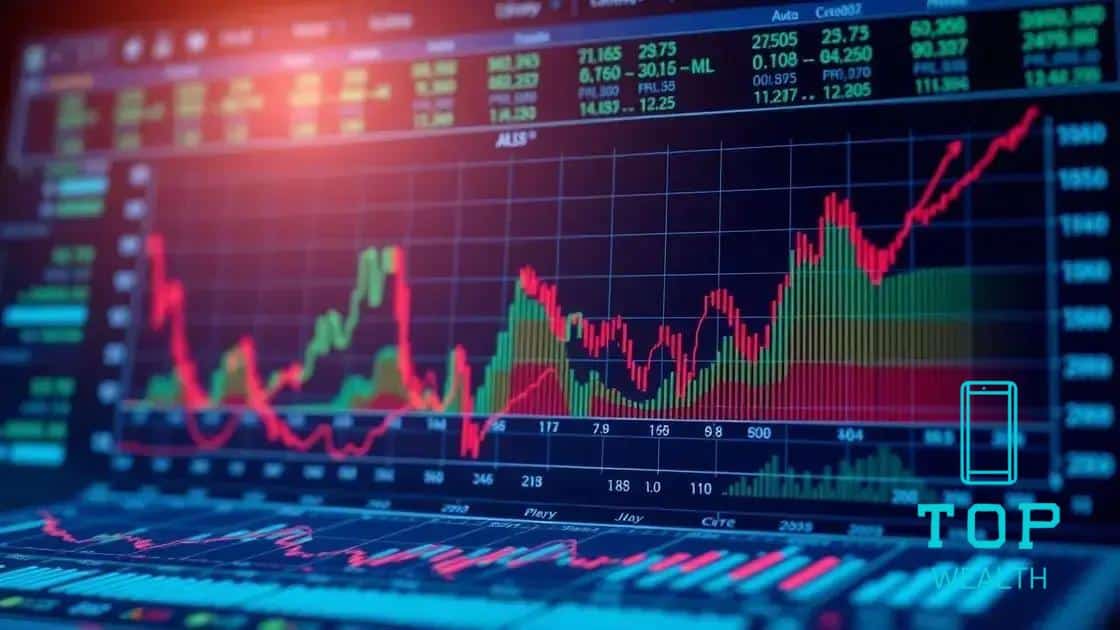Inverted yield curves raise fears of economic slowdown

Inverted yield curves raise fears of economic slowdown by indicating a potential recession, impacting investment strategies and necessitating adjustments in savings and financial planning for individuals and businesses.
Inverted yield curves raise fears of economic slowdown, and many are left wondering what that truly signifies for our finances. Have you ever thought about how these financial indicators affect your daily life and future plans?
Understanding inverted yield curves
Understanding inverted yield curves is crucial for both investors and everyday individuals. These curves represent the relationship between interest rates and the maturity of debt. When the yield on short-term bonds exceeds that of long-term bonds, it can create significant concerns about the economic outlook.
What does an inverted yield curve indicate?
An inverted yield curve often suggests that investors expect weaker growth in the future. This situation can lead to decreased consumer spending and lower business investments. Economic analysts closely watch these trends to gauge future market conditions.
Key signals of an economic slowdown:
- Increased unemployment rates
- Reduced consumer confidence
- Declining manufacturing activity
- Lower GDP growth
Recognizing these signals can help individuals prepare for potential economic changes. Investors may alter their strategies to mitigate risks associated with an overall economic slowdown. Inverted yield curves serve as a warning sign, and understanding them helps in making informed decisions.
It’s essential to note that while an inverted yield curve is a historical predictor of recessions, it is not definitive proof of one happening soon. Many other factors contribute to economic performance and can influence these indicators. Keeping abreast of financial news can provide context to these shifts.
Historical context and patterns

The historical context of inverted yield curves is rich and complex. It dates back decades and serves as a critical signal in economic monitoring. Observing past instances can provide insight into potential future trends.
Notable historical cases
Throughout history, inverted yield curves have often preceded economic downturns. For example, in the early 2000s, a significant inversion led to the recession that followed. Understanding these patterns can help demystify the current economic landscape.
Key patterns to recognize:
- Typically occur prior to recessions
- Lasted several months before major downturns
- Varied severity and duration in different economic cycles
- Signal investor concerns about economic growth
Economic experts analyze these patterns to predict future movements in the marketplace. When the yield curve inverts, many investors reassess their strategies. The importance of recognizing historical patterns cannot be overstated, as they offer clues into the behavior of the markets.
Moreover, examining different financial environments enhances understanding. For instance, the yield curve shape may be influenced by various factors such as interest rate policies and international events. Each inversion has its unique story, shaped by the prevailing economic conditions.Learning from history gives investors valuable lessons, showing that while patterns can inform predictions, external influences remain key to understanding economic fluctuations.
Impact on investments and savings
The impact on investments and savings during periods of inverted yield curves cannot be overlooked. Investors often become anxious during these times as they assess market conditions and potential risks. Understanding how these changes affect different assets is vital for making informed decisions.
Effects on investment strategies
When the yield curve inverts, it signals potential economic slowdowns. This often leads investors to shift their focus from riskier assets to safer options. For instance, stocks may become less attractive compared to bonds, as lower interest rates can affect corporate profits.
Key considerations for investors:
- Shifting to more defensive stock positions
- Evaluating bond investments with short maturities
- Considering alternative investments like real estate
- Increased focus on dividend-paying stocks
As the economic climate changes, many individuals reevaluate their savings plans. Traditional savings accounts may offer limited returns during these periods. Thus, exploring different saving options becomes essential. Individuals might turn to high-yield savings accounts or consider certificates of deposits as alternatives.
Furthermore, understanding interest rates and their potential movements can guide savings decisions. Lower rates can mean lower returns, making it important to assess the safety of funds versus the returns they might generate. With inverted yield curves, the emphasis on maintaining liquidity while seeking returns becomes even more critical.
Expert opinions and forecasts
Examining expert opinions and forecasts regarding inverted yield curves offers valuable insights into potential economic outcomes. Many financial analysts and economists monitor these indicators closely to gauge market health. Their perspectives provide a broader understanding of what to expect in the coming months.
Insights from economic experts
Professionals often debate the implications of inverted yield curves. Some see it as a warning sign of an approaching recession, while others argue it could be a false alarm. Analyzing historical contexts helps in making these predictions more precise. Economic experts frequently highlight the importance of considering various factors, such as the Federal Reserve‘s monetary policy and global economic conditions.
Key points from forecasts:
- Potential for a slowdown in consumer spending
- Risk of job losses if recession occurs
- Variation in impact across different sectors
- Opportunities in defensive investment strategies
Moreover, analysts often adjust their forecasts based on changing circumstances. For instance, if inflation rates increase or there are shifts in fiscal policy, experts may reevaluate expected outcomes. These adjustments are crucial for investors and individuals looking to stay informed about economic trends.
Understanding the range of expert opinions helps individuals and businesses prepare better for potential scenarios. By following leading economists and their recommendations, it’s possible to make more informed financial choices. Knowledge of expert forecasts can also empower investors to take calculated risks while remaining aware of the shifting economic landscape.
Strategies for navigating economic changes
Navigating economic changes during periods of inverted yield curves requires thoughtful strategies. Individuals and investors must adapt to shifting market conditions to protect their financial health. Knowing how to respond to these changes can make a significant difference.
Proactive financial planning
One effective strategy is to engage in proactive financial planning. This means regularly reviewing investments and adjusting them based on current economic indicators. Keeping an eye on the yield curve can help anticipate potential shifts in the market.
Important strategies to consider:
- Diversifying investment portfolios to reduce risk
- Focusing on defensive stocks that tend to perform well during slowdowns
- Maintaining liquidity to take advantage of emerging opportunities
- Considering fixed-income investments that may offer stability
Additionally, it’s wise to stay informed about economic news and trends. This information can provide valuable context for understanding market behavior. Being aware of factors like interest rate changes and government policies greatly influences decision-making.
Many investors also find it beneficial to consult financial advisors. Expert guidance can lead to better investment choices during volatile times. These professionals can offer tailored advice based on individual financial goals and circumstances.
Alongside investments, individual savings strategies should also evolve. Individuals might benefit from reassessing their saving methods. For example, moving funds to high-yield savings accounts can enhance returns in a low-interest-rate environment. By adopting a flexible approach and being open to adjusting strategies, individuals can better navigate economic changes and protect their financial futures.
In conclusion, understanding the implications of inverted yield curves is essential for navigating economic changes. These curves signal potential slowdowns, affecting investments and savings strategies. By adopting proactive approaches and staying informed, individuals can protect their finances. Engaging with experts and adjusting financial behaviors ensures better preparedness for the challenges ahead. Recognizing these patterns empowers investors and individuals, enabling them to make informed decisions during uncertain times.
FAQ – Frequently Asked Questions about Inverted Yield Curves and Economic Impact
What is an inverted yield curve?
An inverted yield curve occurs when short-term interest rates are higher than long-term rates, often signaling a potential economic slowdown.
How does an inverted yield curve impact investments?
It often leads investors to shift towards safer investments, such as bonds, and reassess their risk exposure in the stock market.
What should I do with my savings during an inverted yield curve?
Consider high-yield savings accounts or other low-risk investment options to protect your savings from potential economic downturns.
Why is expert opinion important during economic changes?
Expert opinions provide valuable insights and can help inform better financial decisions amidst uncertainty and changing market conditions.





